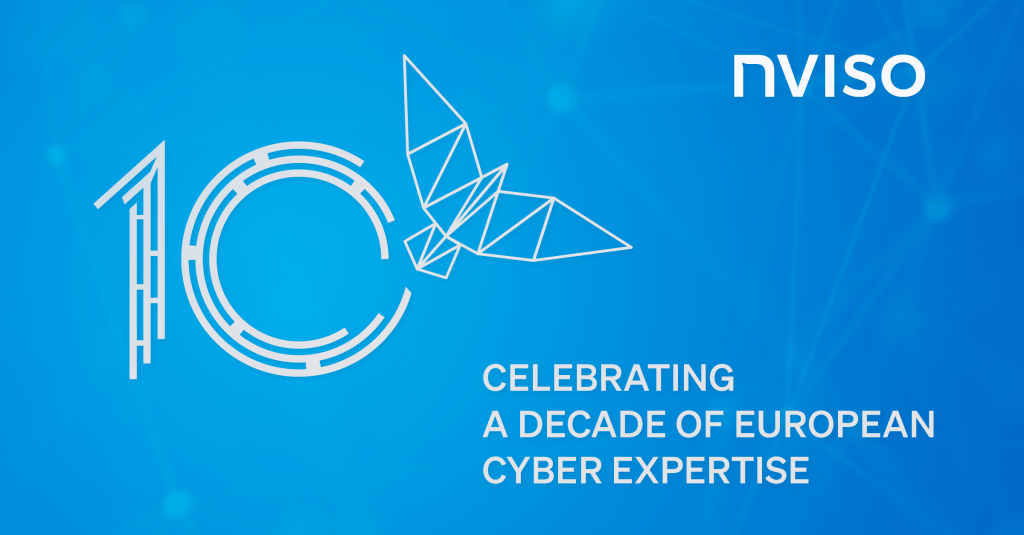From 5 people to almost 250 people. From working from our founders’ apartment to five offices in four countries. From an unknown challenger to being a reference in multiple fields in cyber security.
As a company, NVISO has come a long way since 2013 and we want to take a moment to celebrate what we have accomplished together so far.

In 2013, NVISO was founded by five young security professionals with a dream:
To build a home and a hub for cyber security experts, here in the heart of Europe.
- A team built on strong values.
- A place that prioritizes personal growth and encourages everyone to innovate.
- A community of experts that strives to be the best at what they do.
- All working towards the mission of protecting European society from potentially devastating cyber attacks.
Together, we made it a reality!
This would not have been possible without the trust of our clients & partners and, most crucially, the dedication of every single NVISO bird. Thank you all!

Over the past decade, our team has made significant contributions to the field of cybersecurity through research and innovative solutions.
So, let’s take a trip down memory lane and revisit ten of the most influential articles from our blog!
- ApkScan
Back in 2013, our first research project was a scanner for APKs; that Android malware analysis tool was very successful, being cited in academic papers, and helped us rapidly build knowledge and experience with what was then a relatively new challenge, mobile security. (Read more)
- Intercept Flutter traffic on iOS and Android
Mobile security remains one of our big focus points, and this blogpost offers practical guidance for other testers on how to bypass SSL pinning, intercept HTTPS traffic, and use ProxyDroid during their mobile security assessments. (Read more)
- My journey reaching #1 on Hack The Box Belgium – 10 tips, tricks and lessons learned
Inspiring others by sharing a personal success story – in this case, reaching the #1 spot on Hack The Box Belgium – is something we really encourage our colleagues to do. Combining hands-on tips with a few motivational memes mixed was the recipe for this popular & often-shared blog post! (Read more) - Painless Cuckoo Sandbox Installation
Sharing hands-on practical tutorials on how to solve a certain problem we had to deal with ourselves, has proven to be a good source for blog posts: practical tutorials where we share source code are some of the most searched blog posts we publish. This particular blog post explains how to set up a Cuckoo sandbox for analyzing malware samples, which is useful for blue team members who need to analyze a suspected malware sample without submitting it to online malware analysis services that may alert adversaries. (Read more)
- A practical guide to RFID badge copying
Deciding which information (not) to publish is always an important balancing act: on one hand, we want to share important information about vulnerabilities as much as possible, while also protecting potential victims without encouraging illicit use of the information. We decide to share this particular blog post to raise awareness about the potential security risks associated with RFID card reading systems, which are often the sole factor of security that prevents unauthorized access to buildings, server rooms, and offices. The post demonstrates how easy it is to clone and abuse RFID cards using specialized hardware, such as the Proxmark3, when the card reader security mechanism is insufficiently secured. (Read more) - DeTT&CT: Mapping detection to MITRE ATT&CK
Detailed and hands-on guide on mapping your detection capabilities to MITRE ATT&CK using MITRE DeTT&CT. Using this it becomes easier to build and maintain rules, and spot your blind spots! (Read more) - Another spin to Gamification: how we used Gather.town to build a (great!) Cyber Security Game
People are at the heart of cybersecurity. In this blog post, we outline how we crafted an – if we may say so ourselves – fun and informative game using Gather.town to promote cybersecurity awareness, and tell you how you can too. (Read more) - PowerShell Inside a Certificate? – Part 1
Didier Stevens outlines in this blog post how we crafted YARA detection rules that don’t just detect things we know are bad, but also checks whether things actually have the format we expect them to. This way we found some PowerShell code hidden in Certificate files. (Read more) - Detecting DDE in MS Office documents
Didier Stevens shares in this blog post how to detect Dynamic Data Exchange, an old technology often abused to weaponize MS Office documents. We believe sharing tips and detection rules like this one makes us all more secure in the end! (Read more) - Under the hood: Hiding data in JPEG images
In this lighthearted blog post, we dive under the hood of how you can hide your secrets inside a JPEG file. We recommend using this as a party trick or as a fun challenge, not for your TLP Red stuff! (Read more)
